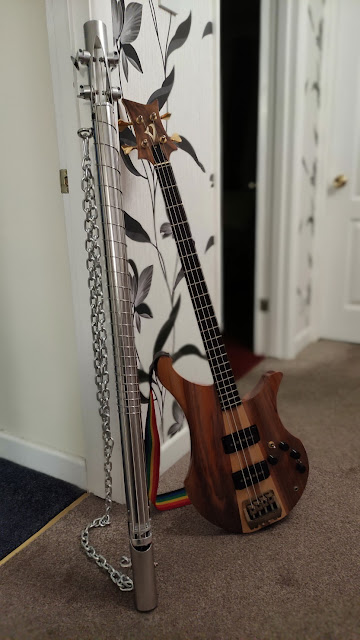Bouncing along
After a successful wind-up, the completed spring was slid onto the main tube. A 90 degree bend made at the bridge end allowed the coil to be anchored by passing the wire through the last fret position hole (drilled earlier for guidance). Each coil was nudged into position before fastening at the head end using a bicycle brake cable clamp-bolt. Finally the entire spring was glued to the tube with epoxy resin to prevent it wandering about. This was a bit messy and a fair bit of IPA was used in cleaning off the excess before it set.
Tuners
Conventional closed gear tuners were used. These are normally fitted into the headstock which is around 15mm thick. The stainless tube is only 1.5mm thick and is curved! To get around this (quite literally) four circular aluminium spacers with OD = 30mm, ID = 16mm and length 24mm were sawn into 16mm & 8mm lengths then shaped to fit either side of the tube wall.
It took a fair bit of whittling to match the tube shape. The tuners were then fitted to the tube using these spacers to sandwich it all together. The smaller convex spacer is on the inside. The small wood screw that normally prevents the tuners turning under tension is replaced with an M2 bolt that also passes through the main tube wall and clamps both parts of the shaped spacer.
Bridge
The separate parts of the bridge were assembled into fixed and adjustable sub-assemblies. The fixed part is bolted to the body tube and the adjustable part is clamped to this using M6 x 75mm bolts. This allows +/-4mm of height adjustment and a certain amount of sideways wiggle too. Angled holes were drilled into the taller end part of the bridge for the strings to pass through before sanding and polishing.
The string grooves were cut into the saddle, and a horizontal groove cut underneath to allow space for the piezo pickup (see below). A drawback of this single saddle style of bridge is the limited intonation adjustment. I'm over it already...
Pickup
As this guitar is based on a tube, the strings cannot 'fan-out' from the nut to a larger bridge spacing without causing the action to increase significantly too. The spacing at the bridge is kept to be nominally the same as at the nut to prevent this increase in the action height and therefore requires a very small pickup too.
The smallest pickup I could find was for a Ukulele. Even this was too long so it had to be dismantled. The individual piezo elements measured around 7.5 x 1.2 x 1.2mm.
The first attempt sounded wrong using 3 elements. The middle element must have been too high causing The E-string end to be very weak. The centre element was removed second time around and with just two elements it sounded peachy!
Altogether Now
I'm very pleased with the spiral frets - they are no more difficult to play than straight ones. I deliberated over shimming the zero fret to make it slightly taller but actually got round to it. A truss rod was not required as the neck is an inherently stronger shape and shrugs off the string tension without showing any signs of curvature at all. A properly set up bass neck does actually have a slight bow to accommodate the string as it vibrates back and forth. This cannot be achieved here.
I've never used piezo pickups before and the sound covers the full audio range regardless of cable length. A common-place wound inductive pickup will have an electrical resonance that can be worsened by excessive cable capacitance. This can be caused by a long or a cheap cable. Above this resonant peak, which can itself add a bit of sparkle in the right place, the output drops noticeably reducing the amplitude of higher frequencies. The piezo pickup is in essence a capacitive pickup and additional cable capacitance makes very little difference.
The tonal character of a stainless steel tubular body, new strings and a piezo pickup system result in an extremely bright sound. This can be tempered by adjusting the playing position of the right hand to give a fuller sound. The same trick can be done on a conventional guitar but due to typical body shapes only a small range of playing positions seem feasible. On the tubular bass, there is no body or other points of reference, so the right hand can carry on up the fret board giving almost hollow synth-like tones.
Other than that, to be honest, it's a complete nightmare to play 😮 The string spacing is very tight for the right hand, and the picking hand has to reach round under the tube for the higher strings.
Ergonomics were not that high on the list of important considerations.
It has stretched the concept of guitar construction in a new direction, but also reinforced that conventional guitars are good examples of incremental development. That being said, with a D-shaped tube and some welding, a more familiar neck and body could be crafted giving rise to an instrument that would have more universal appeal.
But I like the prototype - it still looks like an exhaust pipe from a Lamborghini Murcielago 😊












